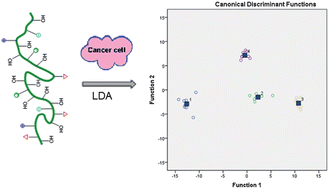By Jennifer A. Dougan, Imperial College London, Web Writer
Sanku Mallik and co-workers from North Dakota State University have developed a method for the post-translational discrimination of breast cancer cell sub-types. The researchers have achieved this by use of water soluble fluorescent polymers which are designed to interact with proteins, enzymes and amino acids. The fluorescence spectra from the polymers when exposed to the conditioned culture media of different cells lines were subject to linear discriminant analysis and used to discriminate between four cell lines and between breast cancer and other tissue types. Although the particular proteins or other biomolecular species and interactions responsible for the spectral changes have not yet been elucidated, this report is an interesting post-translational alternative to standard molecular biology techniques. This paper will be free to read until Nov 20th.
Fluorescent polymer-based post-translational differentiation and subtyping of breast cancer cells
Michael D. Scott, Rinku Dutta, Manas K. Haldar, Anil Wagh, Thomas R. Gustad, Benedict Law, Daniel L. Friesner and Sanku Mallik
Analyst, 2012, 137, 5487-5490
DOI: 10.1039/C2AN35877H











